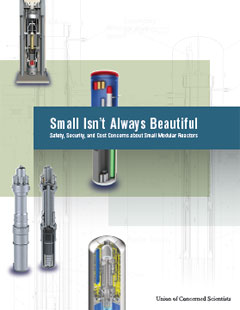According to the U.S. Department of Energy (DOE) and some members of the nuclear industry, the next big thing in nuclear energy will be a small thing: the “small modular reactor” (SMR).
SMRs—“small” because they generate a maximum of about 30 percent as much power as typical current reactors, and “modular” because they can be assembled in factories and shipped to power plant sites—have been getting a lot of positive attention recently, as the nuclear power industry has struggled to remain economically viable in an era of flat demand and increasing competition from natural gas and other energy alternatives.
SMRs have been touted as both safer and more cost-effective than older, larger nuclear reactor designs. Proponents have even suggested that SMRs are so safe that some current NRC regulations can be relaxed for them, arguing that they need fewer operators and safety officers, less robust containment structures, and less elaborate evacuation plans. Are these claims justified?
Economies of scale and Catch-22s
SMR-based power plants can be built with a smaller capital investment than plants based on larger reactors. Proponents suggest that this will remove financial barriers that have slowed the growth of nuclear power in recent years.
However, there's a catch: “affordable” doesn’t necessarily mean “cost-effective.” Economies of scale dictate that, all other things being equal, larger reactors will generate cheaper power. SMR proponents suggest that mass production of modular reactors could offset economies of scale, but a 2011 study concluded that SMRs would still be more expensive than current reactors.
Even if SMRs could eventually be more cost-effective than larger reactors due to mass production, this advantage will only come into play when many SMRs are in operation. But utilities are unlikely to invest in SMRs until they can produce competitively priced electric power. This Catch-22 has led some observers to conclude that the technology will require significant government financial help to get off the ground.
Are small modular reactors safer?
One of the chief selling points for SMRs is that they are supposed to be safer than current reactor designs. However, their safety advantages are not as straightforward as some proponents suggest.
- SMRs use passive cooling systems that do not depend on the availability of electric power. This would be a genuine advantage under many accident scenarios, but not all. Passive systems are not infallible, and credible designs should include reliable active backup cooling systems. But this would add to cost.
- SMRs feature smaller, less robust containment systems than current reactors. This can have negative safety consequences, including a greater probability of damage from hydrogen explosions. SMR designs include measures to prevent hydrogen from reaching explosive concentrations, but they are not as reliable as a more robust containment—which, again, would add to cost.
- Some proponents have suggested siting SMRs underground as a safety measure. However, underground siting is a double-edged sword—it reduces risk in some situations (such as earthquake) and increases it in others (such as flooding). It can also make emergency intervention more difficult. And it too increases cost.
- Proponents also point out that smaller reactors are inherently less dangerous than larger ones. While this is true, it is misleading, because small reactors generate less power than large ones, and therefore more of them are required to meet the same energy needs. Multiple SMRs may actually present a higher risk than a single large reactor, especially if plant owners try to cut costs by reducing support staff or safety equipment per reactor.
Relaxing security standards
The April 2013 bombings at the Boston Marathon remind us that terrorism is an ongoing threat. Yet the nuclear industry is proposing weaker security standards for SMRs. Industry representatives have suggested potential security force reductions of as much as 70 to 80 percent, which seem likely to leave plants inadequately defended.
Some industry representatives have suggested that underground siting could make SMRs less vulnerable to attack, but this is true only in some possible attack scenarios—in others, underground siting could work in the attackers' favor. No matter what safeguards are added to a plant's design, a robust and flexible security force will be needed.
Shrinking evacuation zones
Because of SMRs' alleged safety advantages, proponents have called for shrinking the size of the emergency planning zone (EPZ) surrounding an SMR plant from the current standard of 10 miles to as little as 1000 feet, making it easier to site the plants near population centers and in convenient locations such as former coal plants and military bases.
However, the lessons of Fukushima, in which radiation levels high enough to trigger evacuation or long-term settlement were measured at as much as 20 to 30 miles from the accident, suggest that these proposals, which are based on assumptions and models that have yet to be tested in practice, may be overoptimistic.
Conclusions
- Unless a number of optimistic assumptions are realized, SMRs are not likely to be a viable solution to the economic and safety problems faced by nuclear power.
- While some SMR proponents are worried that the United States is lagging in the creation of an SMR export market, cutting corners on safety is a shortsighted strategy.
- Since safety and security improvements are critical to establishing the viability of nuclear power as an energy source for the future, the nuclear industry and the DOE should focus on developing safer reactor designs rather than weakening regulations.
- Congress should direct the DOE to spend taxpayer money only on support of technologies that have the potential to provide significantly greater levels of safety and security than currently operating reactors.
- The DOE should not be promoting the idea that SMRs do not require 10-mile emergency planning—nor should it be encouraging the NRC to weaken its other requirements just to facilitate SMR licensing and deployment.




